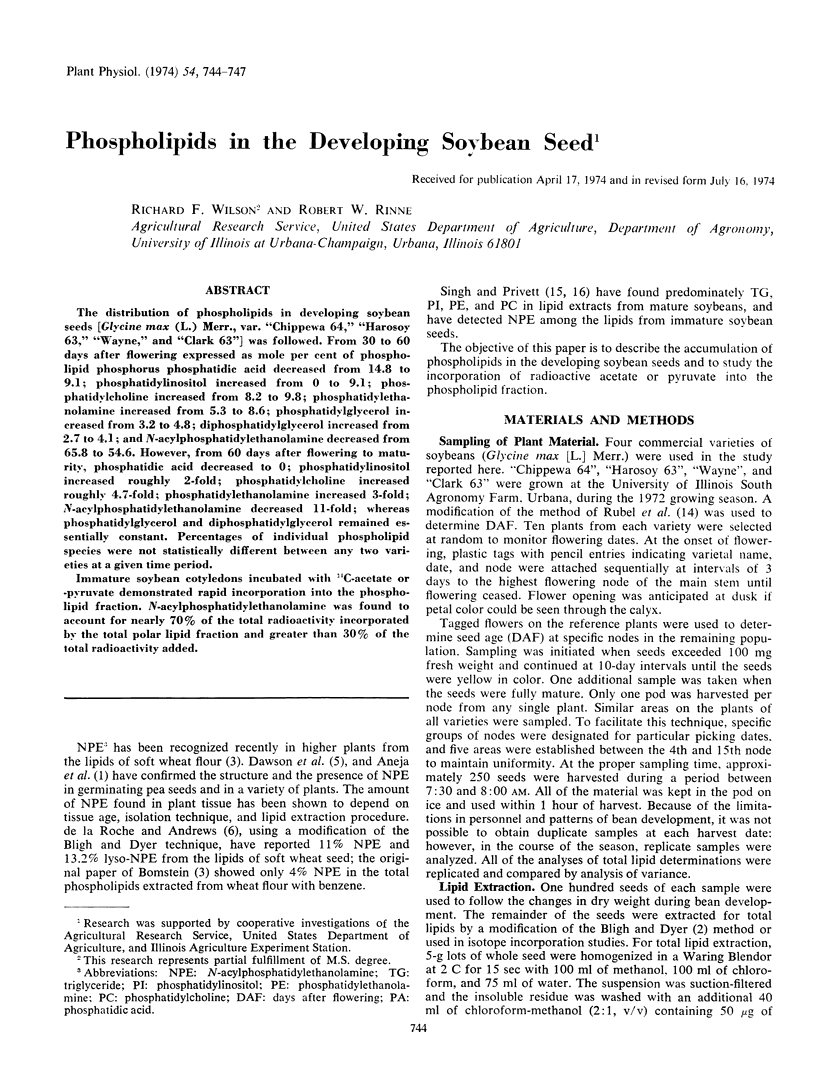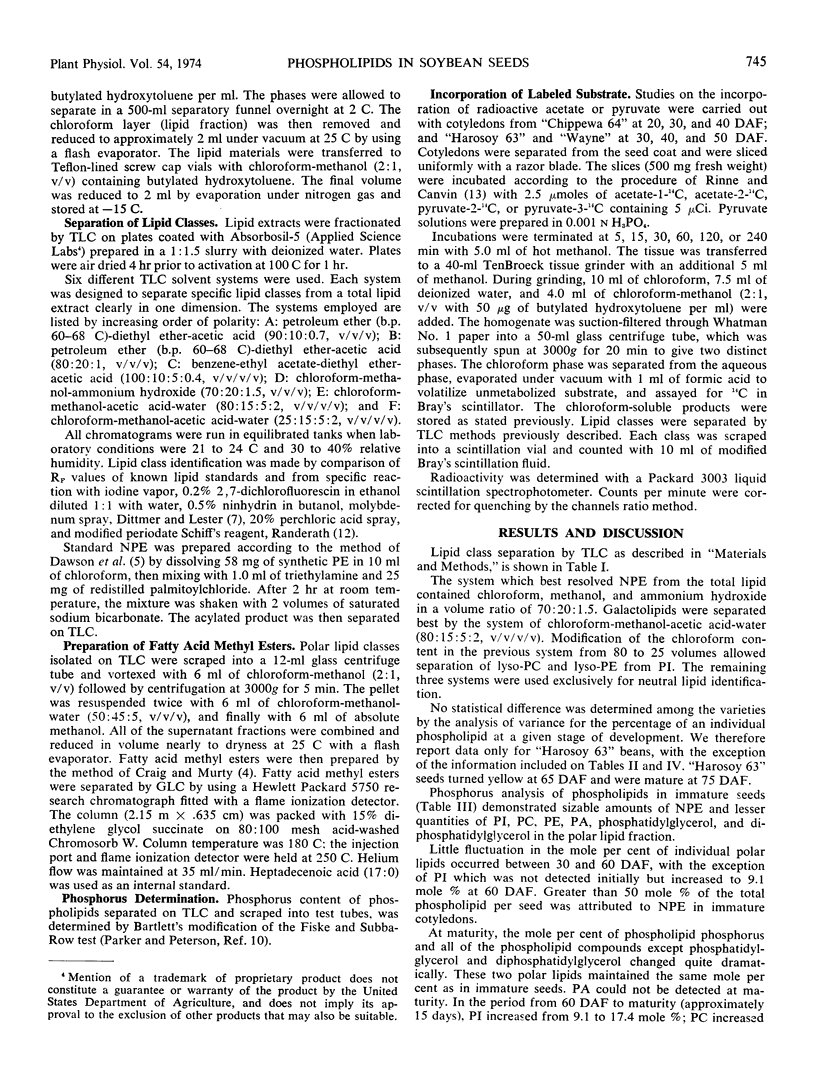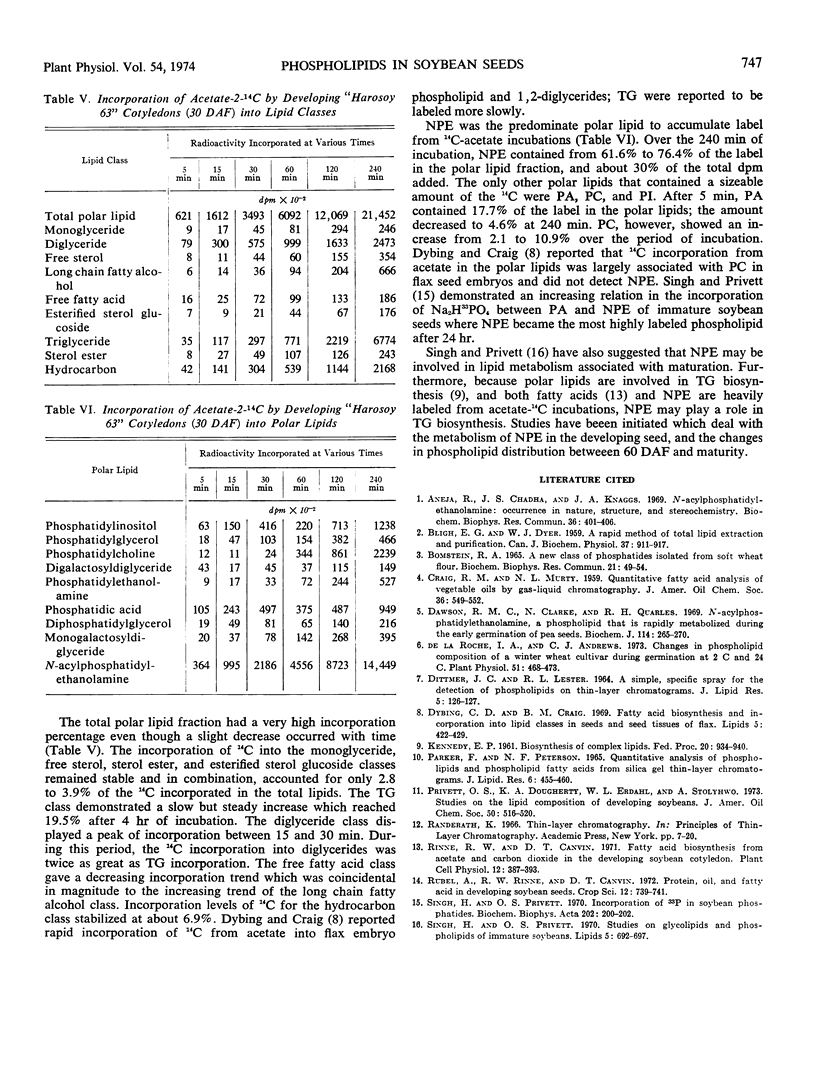Abstract
The distribution of phospholipids in developing soybean seeds [Glycine max (L.) Merr., var. “Chippewa 64,” “Harosoy 63,” “Wayne,” and “Clark 63”] was followed. From 30 to 60 days after flowering expressed as mole per cent of phospholipid phosphorus phosphatidic acid decreased from 14.8 to 9.1; phosphatidylinositol increased from 0 to 9.1; phosphatidylcholine increased from 8.2 to 9.8; phosphatidylethanolamine increased from 5.3 to 8.6; phosphatidylglycerol increased from 3.2 to 4.8; diphosphatidylglycerol increased from 2.7 to 4.1; and N-acylphosphatidylethanolamine decreased from 65.8 to 54.6. However, from 60 days after flowering to maturity, phosphatidic acid decreased to 0; phosphatidylinositol increased roughly 2-fold; phosphatidylcholine increased roughly 4.7-fold; phosphatidylethanolamine increased 3-fold; N-acylphosphatidylethanolamine decreased 11-fold; whereas phosphatidylglycerol and diphosphatidylglycerol remained essentially constant. Percentages of individual phospholipid species were not statistically different between any two varieties at a given time period.
Immature soybean cotyledons incubated with 14C-acetate or -pyruvate demonstrated rapid incorporation into the phospholipid fraction. N-acylphosphatidylethanolamine was found to account for nearly 70% of the total radioactivity incorporated by the total polar lipid fraction and greater than 30% of the total radioactivity added.
Full text
PDF



Selected References
These references are in PubMed. This may not be the complete list of references from this article.
- Aneja R., Chadha J. S., Knaggs J. A. N-Acylphosphatidylethanolamines: occurrence in nature, structure and stereochemistry. Biochem Biophys Res Commun. 1969 Aug 7;36(3):401–406. doi: 10.1016/0006-291x(69)90578-6. [DOI] [PubMed] [Google Scholar]
- BLIGH E. G., DYER W. J. A rapid method of total lipid extraction and purification. Can J Biochem Physiol. 1959 Aug;37(8):911–917. doi: 10.1139/o59-099. [DOI] [PubMed] [Google Scholar]
- Bomstein R. A. A new class of phosphatides isolated from soft wheat flour. Biochem Biophys Res Commun. 1965 Oct 8;21(1):49–54. doi: 10.1016/0006-291x(65)90424-9. [DOI] [PubMed] [Google Scholar]
- DITTMER J. C., LESTER R. L. A SIMPLE, SPECIFIC SPRAY FOR THE DETECTION OF PHOSPHOLIPIDS ON THIN-LAYER CHROMATOGRAMS. J Lipid Res. 1964 Jan;5:126–127. [PubMed] [Google Scholar]
- Dawson R. M., Clarke N., Quarles R. H. N-acylphosphatidylethanolamine, a phospholipid that is rapidly metabolized during the arly germnation of pea seeds. Biochem J. 1969 Sep;114(2):265–267. doi: 10.1042/bj1140265. [DOI] [PMC free article] [PubMed] [Google Scholar]
- KENNEDY E. P. Biosynthesis of complex lipids. Fed Proc. 1961 Dec;20:934–940. [PubMed] [Google Scholar]
- Privett O. S., Dougherty K. A., Erdahl W. L., Stolyhwo A. Studies on the lipid composition of developing soybeans. J Am Oil Chem Soc. 1973 Dec;50(12):516–520. doi: 10.1007/BF02640523. [DOI] [PubMed] [Google Scholar]
- Singh H., Privett O. S. Incorporation of 33P in soybean phosphatides. Biochim Biophys Acta. 1970 Feb 10;202(1):200–202. doi: 10.1016/0005-2760(70)90236-5. [DOI] [PubMed] [Google Scholar]
- Singh H., Privett O. S. Studies on the glycolipids and phospholipids of immature soybeans. Lipids. 1970 Aug;5(8):692–697. doi: 10.1007/BF02531436. [DOI] [PubMed] [Google Scholar]
- de la Roche I. A., Andrews C. J. Changes in Phospholipid Composition of a Winter Wheat Cultivar during Germination at 2 C and 24 C. Plant Physiol. 1973 Mar;51(3):468–473. doi: 10.1104/pp.51.3.468. [DOI] [PMC free article] [PubMed] [Google Scholar]


